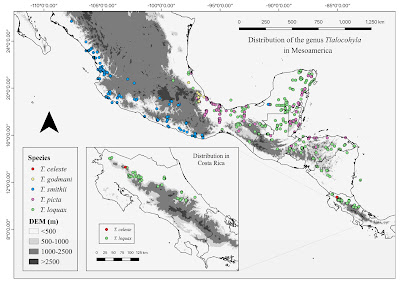 |
| Tlalocohyla celeste Varela-Soto, Abarca, Brenes-Mora, Aspinall, Leenders & Shepack, 2022 |
Abstract
A new species of hylid frog is described from Tapir Valley Nature Reserve, located on the Caribbean slope of Tenorio Volcano in Bijagua, Alajuela Province, Costa Rica. A molecular phylogenetic analysis supports its inclusion in the genus Tlalocohyla. Morphological, morphometric, larval, and acoustic characteristics further distinguish it from other species in the genus and support its uniqueness. The new species is closely related to T. picta and T. smithii, and is separated by at least 500 kilometers from the nearest known occurrence of a population of T. picta in southern Honduras. The new species is readily distinguished from all other Tlalocohyla by its brilliant green coloration marked with a pronounced, incomplete light dorsolateral stripe that is bordered above by a diffuse reddish-brown stripe. Its dorsum is marked with bold reddish brown spots and its ventral skin is fully transparent. This new Tlalocohyla is currently only known from the type locality, where it inhabits a lentic wetland system with an emergent herbaceous vegetation-dominated benthic zone, surrounded by tropical rainforest. A description of its bioacoustic repertoire and information on natural history, reproduction and habitat preference of this new species are provided.
Keywords: Amphibia, Tlalocohyla celeste sp. nov., Middle America, Costa Rica, Hylidae, tree frog, taxonomy, endangered species
Tlalocohyla celeste sp. nov.
Tapir Valley Tree Frog,
Rana Arbórea del Valle del Tapir
Diagnosis. The new species can be diagnosed by the following combination of traits: (1) small size (adults males: 21 mm, females: 24 mm of SVL; n=4); (2) tympanic membrane not-evident; (3) vocal sac developed, single, subgular, extending to the pectoral region; (4) vomerine teeth absent; (5) dorsal color yellow-green (#103); (6) ventral skin transparent; (7) white peritoneum covering all internal organs; (8) presence of an incomplete sulfur white (#96) dorsolateral stripe that originates at the posterior edge of the orbit and extends posteriorly to a point more than halfway towards the insertion of each hindlimb, bordered above for its entire length by a diffuse mahogany red (34) stripe that extends anteriorly towards the tip of the snout; (9) presence of a small light cyan (#158) axillary membrane.
Natural history. Individuals of this new species have been observed catching small flies and micro moths, and presumably its diet consists of a variety of small invertebrates. Although no direct observations of predation on adult T. celeste were made, its wetland habitat harbors abundant snakes that are known predators of anurans. In addition, ctenid spiders, which are common frog predators, abound. During the course of our surveys, opilionid arachnids were observed scavenging a dead frog and small wasps were seen attacking T. celeste egg masses and preying on early developing larvae
Etymology. The specific epithet “celeste” (light blue, or sky-blue in Spanish), is used as a noun in apposition, and refers to the striking blue coloration seen on this frog’s axillary membranes and groin area, as well as on the inflated vocal sac in adult males. Perhaps more importantly, the authors want to celebrate the river Río Celeste, famous for the distinctive turquoise-blue hue of its water, whose watershed feeds the wetlands that provide critical habitat for its namesake frog. Río Celeste represents a critical natural resource and an important economic driver for local communities, as well as a nexus for sharing the beauty of nature with visitors from outside the region. The fact that this frog was discovered through local wetland restoration efforts is a testament to the critical importance of protecting our aquatic resources.
Donald Varela-Soto, Juan G. Abarca, Esteban Brenes-Mora, Valeria Aspinall, Twan Leenders and Alex Shepack. 2022. A New Species of Brilliant Green Grog of the Genus Tlalocohyla (Anura, Hylidae) hiding between Two Volcanoes of northern Costa Rica. Zootaxa. 5178(6); 501-531. DOI: 10.11646/zootaxa.5178.6.1
facebook.com/TwanLeenders9/posts/10228216922997587










